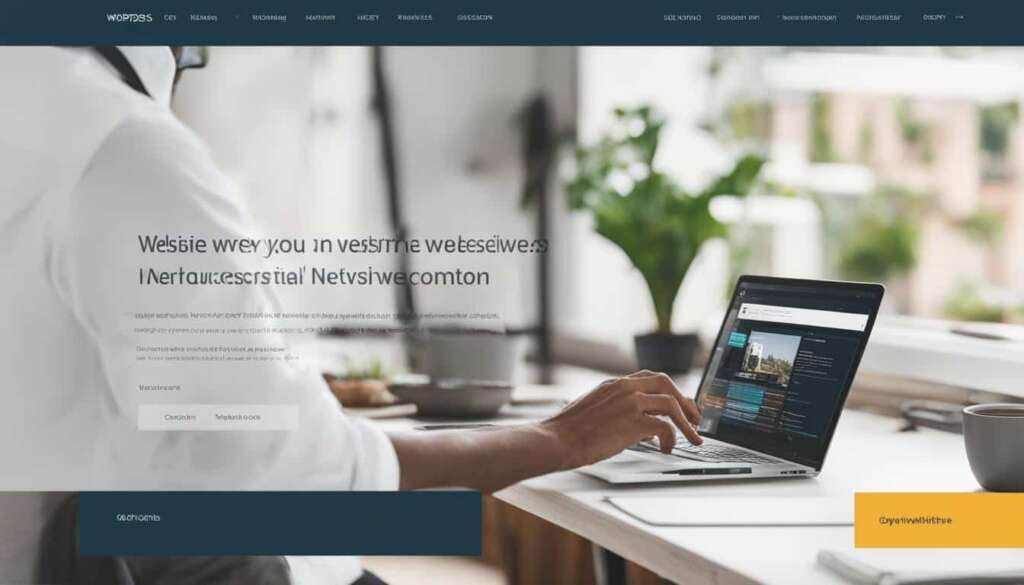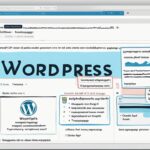Table of Contents
Welcome to our WordPress site editing guide. If you’re looking to make changes to your WordPress website, you’ve come to the right place. In this comprehensive guide, we’ll take you through the different ways you can easily edit your WordPress site, whether you’re a beginner or an experienced user.
Editing your WordPress site doesn’t have to be complicated. With the right tools and knowledge, you can customize your site’s design, layout, and content to meet your specific needs. Whether you want to update the colors and fonts, modify the header and footer, or add new elements, we’ll show you how to do it step by step.
In this guide, we’ll cover three primary methods for editing your WordPress site:
1. Using the Site Editor: Access the Site Editor in your WordPress dashboard to design and modify various elements of your site with ease. We’ll show you how to navigate the editor and make the changes you desire.
2. Using the Block Editor (Gutenberg): Make use of the Block Editor to edit your pages or posts by adding and modifying content blocks. We’ll walk you through the functionalities and customization options of the Block Editor.
3. Using the Classic Editor: If you prefer a more traditional editing experience, the Classic Editor is here for you. Powered by TinyMCE, you’ll find it simple and straightforward to customize your site’s content to your liking.
Additionally, we’ll explore how you can leverage page builders, such as Divi, Elementor, and Beaver Builder, to create custom layouts and achieve a unique design for your WordPress site.
With our editing guide, you’ll gain the knowledge and confidence to easily edit your WordPress site. Whether you’re a beginner or an experienced user, our step-by-step instructions and insights will help you navigate the editing process seamlessly. Stay tuned for the next sections to discover the different editing methods and choose the one that suits you best.
Using the Block Editor (Gutenberg) to Edit Your WordPress Site
The WordPress Block Editor, also known as Gutenberg, provides a user-friendly option for editing your WordPress site. With the Block Editor, you have the flexibility to add, modify, and customize content on your pages or posts using blocks.
Each block represents a specific content element, such as paragraphs, images, headings, or buttons. By using blocks, you can easily structure and design your content without the need for complex coding or formatting.
To start using the Block Editor, log into your WordPress dashboard and navigate to the page or post you want to edit. Open it in the Block Editor, and you will have access to a wide range of blocks that you can add to your content.
Once you’ve added blocks to your page, you can start making changes by simply editing the text, adding images, or adjusting other elements within each block. The Block Editor provides intuitive customization options for each block, allowing you to modify settings such as font styles, colors, and alignments.
Benefits of Using the Block Editor:
- Easy content creation and editing with a block-based approach
- Drag-and-drop functionality for effortless arrangement of content elements
- Wide selection of blocks for diverse content types and layouts
- Customization options within each block for personalized styling
- Live preview of changes before publishing them to your site
The Block Editor empowers you to take full control of your WordPress site’s visual appearance and layout. With its intuitive interface and extensive block library, you can create engaging and professional-looking content without the need for advanced technical skills.
Now let’s take a look at how to use the Block Editor effectively.
Using the Classic Editor to Edit Your WordPress Site
If you prefer a more traditional editing experience, you can use the Classic Editor in WordPress. The Classic Editor is powered by TinyMCE and offers a familiar interface for editing your site’s content.
To use the Classic Editor, log into your WordPress dashboard and open the page or post you want to edit. The Classic Editor allows you to customize various elements, such as headings, font styles, lists, alignments, colors, tables, and media.
You can easily add text, images, and other content to your page or post using the Classic Editor. It’s a simple and straightforward editing option, especially for those who are accustomed to the previous versions of WordPress.
The Classic Editor provides a toolbar with familiar formatting options, including bold, italic, underline, bullet points, and numbered lists. You can also create tables, insert links, add media, and customize the appearance of your content.
Customizing Headings and Font Styles
The Classic Editor allows you to easily customize headings and font styles to emphasize your text. By selecting a block of text, you can change the font size, color, and style to make it stand out.
Working with Lists
Creating lists in the Classic Editor is straightforward. Simply select the text you want to turn into a list, and use the toolbar options to create ordered or unordered lists. You can also nest lists to create sub-points or bullet points within bullet points.
Adding and Formatting Tables
Tables are a great way to present data or create organized layouts. In the Classic Editor, you can easily create tables and format them to suit your needs.
Here’s an example of a table created in the Classic Editor:
| Product | Price | Availability |
|---|---|---|
| Product A | $10 | In Stock |
| Product B | $15 | Out of Stock |
| Product C | $20 | In Stock |
By using the table option in the Classic Editor, you can easily create rows and columns, adjust cell sizes, merge cells, and apply formatting to tables.
Overall, the Classic Editor provides a familiar and user-friendly editing experience for those who prefer a more traditional approach. Whether you’re editing text, adding images, or creating tables, the Classic Editor offers a range of options to customize and enhance your WordPress site’s content.
Editing Your WordPress Site with Page Builders
Another way to enhance your WordPress site editing experience is by using page builders. These powerful plugins provide advanced editing features and enable you to create custom layouts for your pages. With WordPress page builders, you can easily design and arrange various elements on your site using a convenient drag-and-drop interface.
Page builders offer a wide range of blocks and modules that you can add to your website, such as text, images, buttons, sliders, and more. This flexibility allows you to create unique and visually appealing designs without any coding knowledge. Popular page builders in the WordPress community include Divi, Elementor, and Beaver Builder, among others.
To get started with page builders, you’ll need to install and activate the plugin corresponding to your preferred page builder. Once activated, you can access the builder’s intuitive interface, where you’ll find the necessary tools to create stunning web pages. Utilizing a page builder’s drag-and-drop functionality, you can simply add elements and rearrange them on your page, adjusting colors, sizes, and styles to match your brand’s identity.
With page builders, you have the freedom to experiment with different layouts and designs until you achieve the desired result. Take advantage of their vast array of customization options, including pre-designed templates, responsive design settings, and theme compatibility, to create a professional and user-friendly website that meets your unique needs.
Whether you’re an experienced developer or a novice user, page builders make editing your WordPress site a breeze. Their intuitive interfaces and drag-and-drop capabilities simplify the editing process, affording you greater control over your website’s design and layout.
Explore the potential of WordPress page builders to unlock endless possibilities for your website’s aesthetics and functionality. Elevate your editing experience, make your site visually stunning, and provide an enhanced user experience for your visitors.

Comparison of Popular WordPress Page Builders
| Page Builder | Key Features | Price |
|---|---|---|
| Divi | Visual drag-and-drop builder, pre-designed templates, responsive editing, 40+ website elements | Starting from $89 per year |
| Elementor | Live front-end editing, extensive widget library, responsive design settings | Free (with premium extensions starting from $49 per year) |
| Beaver Builder | Front-end editing, intuitive interface, template library, WooCommerce integration | Starting from $99 per year |
Conclusion
Editing a WordPress site doesn’t have to be complicated. Whether you choose to use the Site Editor, the Block Editor, the Classic Editor, or a page builder, there are various options available to suit your editing preferences and needs.
Take advantage of these tools to easily edit and customize your WordPress site, from the overall design and layout to the content of individual pages. With the Site Editor, you can effortlessly modify the header, footer, colors, and fonts of your site using blocks.
If you prefer a more modern approach, the Block Editor (Gutenberg) allows you to add and modify content on your pages or posts using blocks. You can select from a wide range of blocks to create engaging and visually appealing content with ease.
For those who prefer a traditional editing experience, the Classic Editor powered by TinyMCE offers a familiar interface to customize headings, font styles, lists, and more. It’s a straightforward option for users accustomed to previous versions of WordPress.
If you desire more control over the design and layout, page builders such as Divi, Elementor, and Beaver Builder are excellent choices. These plugins enable you to create custom layouts using a drag-and-drop interface, adding elements like text, images, buttons, and sliders with ease.
Remember to save your changes and preview your site before publishing any updates. With a bit of practice and familiarity with the editing options, you’ll be able to confidently make changes and manage your WordPress site with ease.
FAQ
How can I edit my WordPress site?
To edit your WordPress site, you can use the Site Editor, Block Editor (Gutenberg), Classic Editor, or page builders.
What is the Site Editor in WordPress?
The Site Editor in WordPress allows you to design various elements of your site, such as the header, footer, colors, and fonts, using blocks.
How do I access the Site Editor in WordPress?
To access the Site Editor, go to your site’s dashboard, locate the Appearance tab on the left side, and click on Editor.
What should I do if my theme doesn’t support the Site Editor?
If your theme does not support the Site Editor, it is recommended to switch to a supported theme to take advantage of the latest editing features in WordPress.
What is the Block Editor in WordPress?
The Block Editor, also known as Gutenberg, is a feature in WordPress that allows you to easily add and modify content on your pages or posts using blocks.
How do I edit a page or post using the Block Editor?
To edit a page or post using the Block Editor, log into your WordPress dashboard, navigate to the page or post you want to edit, and open it in the Block Editor.
What is the Classic Editor in WordPress?
The Classic Editor in WordPress is a more traditional editing experience powered by TinyMCE, offering a familiar interface for editing your site’s content.
How do I use the Classic Editor in WordPress?
To use the Classic Editor, log into your WordPress dashboard, open the page or post you want to edit, and start making changes by adding or modifying text, images, and other elements.
What are page builders in WordPress?
Page builders are WordPress plugins that provide advanced editing features and allow you to create custom layouts for your pages using a drag-and-drop interface.
Which page builders are popular in WordPress?
Popular page builders in WordPress include Divi, Elementor, and Beaver Builder.
How do I edit my WordPress site using page builders?
To edit your WordPress site with a page builder, you need to install and activate the chosen page builder plugin, then start creating and editing your pages using the page builder’s interface.
Is editing a WordPress site complicated?
Editing a WordPress site doesn’t have to be complicated. Whether you choose to use the Site Editor, the Block Editor, the Classic Editor, or a page builder, there are various options available to suit your editing preferences and needs.












